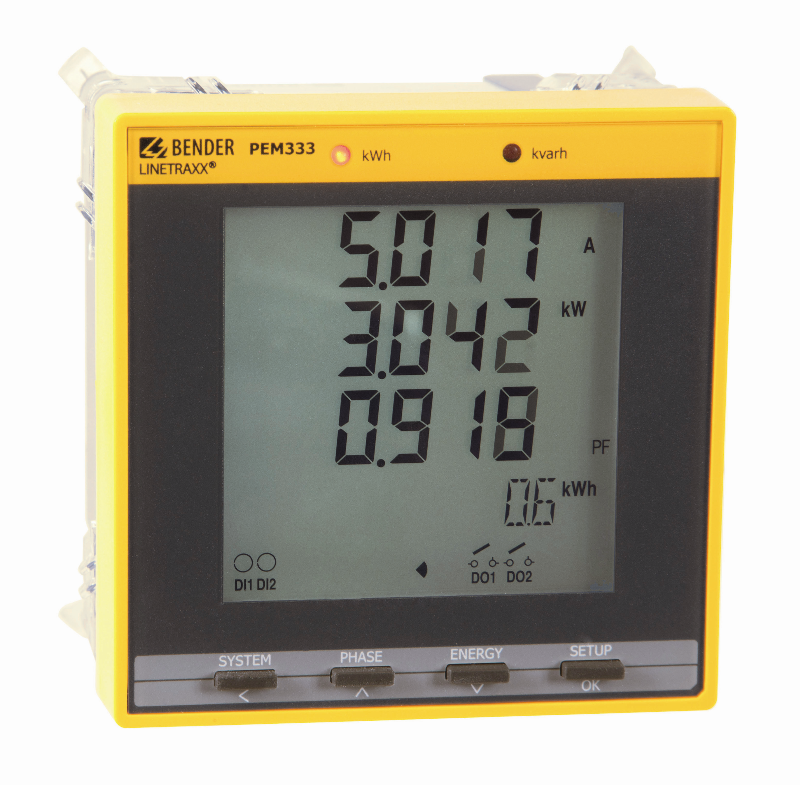 Protecting power distribution systems against risks ranging from reduced service life and increased energy consumption through to system failure and fire in cabling is a priority for any user where unexpected interruption of power supply and system downtime carries heavy consequences.
Protecting power distribution systems against risks ranging from reduced service life and increased energy consumption through to system failure and fire in cabling is a priority for any user where unexpected interruption of power supply and system downtime carries heavy consequences.
New Linetraxx power quality monitoring (PQM) units from Bender UK mitigate these risks and provide the ability to predict and prevent problems, while also reducing costs and avoiding issues caused by so-called ‘dirty’ power systems suffering from interference.
They are available alongside Bender’s residual current monitoring (RCM) units and advanced on-line earth fault location systems to monitor power systems, and are designed to meet the needs of customer sectors from healthcare, rail and marine engineering through to electric cars, data handling centres and solar power generation.
Interference in modern power systems can be caused by frequency converters, switched-mode power supplies, uninterruptible power supply systems (UPS) and electronic ballasts.
These units distort the sine wave of the electrical power and superimpose different frequencies on it – causing the power supply to become ‘dirty’. Systems interactions can also cause interference in neighbouring equipment.
However, monitoring system quality using Bender power quality monitoring (PQM) units ensures high availability and a power supply free from interference.
Harmonic Component Interference
The most frequent problems are caused by harmonic components on the electrical supply – typically produced by other items of electronic equipment. These third order harmonics build up in the neutral conductor and in extreme cases the resulting current can be greater than the individual phase currents. This leads to neutral conductor overload and if the situation goes unnoticed there can be a risk of fire.
 Current regulations require overload detection for the neutral conductor if an excessive load is anticipated due to harmonics, and a protective device normally trips out to protect the neutral conductor.
Current regulations require overload detection for the neutral conductor if an excessive load is anticipated due to harmonics, and a protective device normally trips out to protect the neutral conductor.
However, this safety measure simply moves the problem elsewhere and causes reduced availability due to frequent downtime.
Bender’s monitoring equipment enables early detection of a potentially dangerous situation – allowing enough time to correct the problem without the need to shut down equipment; for example less important loads can be shut down via switching signals before the protective device trips out.
Power quality monitoring is particularly effective when combined with residual current monitoring (RCM) which detects degradation in the level of insulation in an installation or component – again improving availability by signalling the problem at an early stage before safety shutdown.
Reduced Energy Costs
Bender’s PQM device also acts as an energy meter while checking the system quality, determining the energy consumption per cost centre and reducing high overhead costs. For example, it can determine how much energy is consumed by the measures taken to prevent system interaction, and will also show the effect of energy-saving measures on the quality of the electrical supply system.
The dual function of monitoring energy consumption and energy quality therefore assistsd in reducing energy costs while at the same time delivering high availability of supply.
Combining Bender’s RCM and PQM units provides comprehensive protection for electrical supply systems in terms of safety and efficiency:
Safety: RCM delivers continuous monitoring of the residual current to reduce the risk of fire while PQM signals overloads on the neutral conductor and other equipment due to power quality issues.
Efficiency: RCM ensures power installations maintain good EMC characteristics – with no stray protective conductor currents – to deliver trouble free operation and high availability.
Energy management and power quality monitoring (PQM) in one device and one software application enables qualified evaluation of the measures implemented and value delivered in terms of shutdowns avoided.
System Area Monitoring
 Structural detail is a crucial element for effective energy management and cost control in a complex installation because energy use by each cost centre and each different device must be identified. Power Quality Management and Energy Measurement devices can identify individual faults only if the system area monitored is clearly defined.
Structural detail is a crucial element for effective energy management and cost control in a complex installation because energy use by each cost centre and each different device must be identified. Power Quality Management and Energy Measurement devices can identify individual faults only if the system area monitored is clearly defined.
In a typical system a Bender PEM 735 monitors the quality of the voltage for the supply, delivering high resolution logging through measurement of transients, flicker and harmonic components.
The PEM 5 series offers advanced power quality and revenue-accurate measurements, high-resolution waveform recording capabilities, comprehensive data logging with a 4MB log memory, high speed data recording, setpoint alarms, extensive I/O and standard dual RS-485 ports and Modbus protocol support.
PEM 3 series compact universal measuring devices are positioned to replace energy meters and represent cost centres.
This effectively creates an energy management system to control overhead costs for electrical power. This type of monitoring system configuration ensures quick and straightforward analysis to locate power quality phenomena which may put the installation at risk
Bender’s PEM 3 series and PEM 5 series compact devices are designed for front panel mounting as replacements for analogue indicating instruments, with typical applications in low and medium-voltage networks (via measuring voltage transformer).
All measured data is collected, filtered and evaluated at a central point and can now be displayed on the Bender CP700 Condition Monitor – a new generation of gateway.
For more information, please visit www.bender-uk.com/products/power-quality.html

